#clouded leopard conservation
Explore tagged Tumblr posts
Text
Endangered Species Sightings from This Year
This is thought to be the first time in over 20 years that a blue whale was spotted off the Coast of Massachusetts.
I highly recommend watching the video and listening to the reaction of the people on the whale watching boat--the cheers and emotion in some of their voices, especially the woman saying "I'm trying not to" when someone jokingly tells her not to cry.
This is the first time ever that a mother clouded leopard with two cubs has been spotted on a game cam!
"After being considered regionally extinct for over a century, giant anteaters have been spotted roaming once again in Brazil's Rio Grande do Sul state. Scientists have concluded these returned natives ventured over from Argentina's Ibera Park, where conservationists have released around 110 rescued and captive-bred anteaters since 2007."
Over 100 years and the anteaters are finally coming home!
#conservation#animal conservation#biodiversity#good news#environment#whale conservation#wolverine conservation#anteater conservation#rainforest conservation#ocean conservation#hope#optimism#radical optimism#positivity#ecoanxiety#climate anxiety#cat conservation#clouded leopard conservation#zoos prevent extinction
3K notes
·
View notes
Text
youtube
In South Sumatra, conservationist Pungky Nanda Pratama is dedicating his life to conserving what is left of Sumatra’s rainforest.
He is thrilled to hear the call of the rare white-handed gibbon, a species that mates for life, which he describes as “super romantic”.
To show how many endangered species live in this rainforest, Pungky and some friends set up a camera trap project to photograph passing animals. Their footage includes the Sumatran Clouded Leopard, Sun Bears, and Asian Golden Cats.
Indonesia’s iconic wildlife relies on the health of these tropical rainforests.
The area where he is walking is supposed to be protected but already there are signs of open canopy due to illegal clearing, probably for coffee plantations. Palm oil and rubber is also grown in this region.
Pungky is working with local government agencies to collect protected flora from cleared land. Head of conservation for Region I, Martialis Puspito Khristy Maharsi of the Natural Resources Conservation Centre (BKSDA), says extinction is a real threat for some species.
Another threat is poaching for the flora and fauna itself.
Rescued plants are transferred to a large, purpose-built greenhouse. Here it is rehabilitated and propagated. There are about 5,000 specimens here, including hoyas, orchids, aroids, nepenthes and ferns. There are also ant plants (Myrmecodia tuberosa), which have a symbiotic relationship with ants: they provide habitat for ants to nest in their bulbous roots and receive protection from the ants who attack predatory insects.
Orchids such as the critically endangered primrose-yellow slipper orchid are often poached by orchid hunters, despite being protected by law internationally. By propagating through tissue culture, the team hopes to reduce pressure on the plant and return them to the wild.
The urge to collect exotic plants has fed this illegal trade in rare plants.
To help empower local communities on the front line of habitat loss, he works in schools to teach children about the plants and animals living in nearby rainforests. He teaches in 9 schools, some a six-hour walk from the nearest road. He says conservation is not a one- or two-year plan, but a lifetime plan to get communities involved and help find other ways to support their families.
He hopes that people will come to understand that humans depend on nature more than nature depends on us.
Featured Species:
White-handed gibbon (Hybolates lar)
Mitered leaf monkey (Presbytis melalophos)
Featured Plants:
Bulbophyllum sp.
Ant plant (Myrmecodia tuberosa)
Swain’s Coelogyne (Coelogyne swaniana)
Primrose-yellow slipper orchid (Paphiopedilum primulinum)
#Gardening Australia#solarpunk#Sumatra#rainforest#forest#Pungky Nanda Pratama#endangered species#endangered plants#endangered animals#white-handed gibbon#Sumatran Clouded Leopard#Sun Bear#Asian Golden Cats#Natural Resources Conservation Centre#BKSDA#greenhouse#Youtube
3 notes
·
View notes
Text
#africa#alligators#asia#asian elephant#biodiversity#bushmeat#candice gaukel andrews#clouded leopard#conservation#environment#europe#everglades national park#extinction#florida#forests#golf course#grasslands#national parks#natural habitat adventures#nathab#nature#poaching#red deer#rewilding#rhinos#science#science and environment#scientific research#sun bears#tanzania
0 notes
Note
Okay, so I'm gonna contribute to the discourse as someone who did research at both Khao Khaew and the now demolished Dusit Zoo, both part of the Zoological Parks Association Under Royal Patronage (ZPA). And as someone familiar with the workings of AZA zoos as a contrast.
I will concede that on one hand, standards and practices leave a lot to be desired. Unfortunately part of it is connected to the same social norms that have allowed JJ Market to continue the exotic pet trade, animal cafes and roadside zoos to proliferate, and people to own trendy dog breeds that clearly don't belong in Bangkok. And it's what leads to a lot of stereotypic and distressed behaviors passed off as cute (including but not limited to Moo Deng); this is before the toxic element of social media is added to the mix.
There's also economics. Yes, Thailand is technically an industrialized country, but in the same way that Indonesia and Vietnam are (contrast with Singapore, which is proportionately ahead of most Western countries). It's important to see what's between those gleaming skyscrapers. And that is a contributing factor to a lot of resource shortfalls for the zoos themselves; that's not getting into COVID and the ripple effect of closing Dusit Zoo without an alternative in place.
In that regard, the damning thing is that the standards of ZPA zoos are actually leaps and bounds ahead of not just the country but the region (minus Singapore; I would argue that it's actually unproductive to bring its zoo up as a comparison). Like look at Pata and the now defunct Tiger Temple; places that Westerners reveled in as late as the 00s. At least in ZPA case, they have also done essential conservation work; especially for clouded leopards, hornbills, and sun bears.
That doesn't make it any less WTF when I see a lot of clout-chasing vids that
Still part of me can't help but get defensive at the manner of fixation from a primarily western crowd. Both from those who use Western/Industrialized zoos as a way to contrast, as well as the PETA-types.
I do *not* think you yourself are being racist. If anything it's paternalistic to assume that a zoo in Thailand can't be held to higher standards. *However*, I have found a very patronizing mentality among many other western critics that does veer into racism frequently. You are already familiar with the way anti-zoo folks will take something out of context to fit their agenda; now force that through an othering lens.
At the same time, I will concede Thais are glossing over issues and practices when they rush to defend KKZ. Considering the context of how they are approached, I empathize with why they are defensive. But many do downplay and refuse to tackle the aforementioned social norm in how animal husbandry is viewed by wider populace.
TLDR: KKZ and the other ZPA branches have a ton of issues, a lot of those issues are socially systemic, and there should be pressure to reform. At the same time, it shouldn't get canceled, especially considering the important bts work it does and especially the immediate alternatives. And that pressure to reform should be accompanied by resources.
Hey there I really appreciate you sharing your research into the facilities! My intention of the posts has never been to "cancel" the zoo or to dictate their protocols. I don't believe in any sort of western dictation to other countries.
Honestly, I completely understand the defensiveness towards criticism of the handling of Moo Deng - she's an icon, she's brought in millions of dollars into the Thailand economy and the zoo's profits. Tourists are travelling all around the world to see her!
Although it has gotten to the point where their defensiveness is veering into delusion, with people insisting that pygmy hippos love it when you smack them and chase them around so it's fine actually... but I digress...
And I'm sure that the keeper thinks what he's doing is completely fine and not an issue. And if it generates clicks and views, that's good for the zoo, right? So why would they see any point in changing their practises?
I guess my hope is that maybe they might use those millions of dollars to improve conditions for the animals and the staff, provide resources for collaboration with zoos like Singapore Zoo and give keepers more resources to review and improve current pracises.
But they won't do that if their current poor animal husbandry practises are reinforced with clout and feverant defense of the keepers (it's actually kind of amazing how loyal people are to this one keeper!)
So now they have money and potentially more resources from this whole thing - but they're probably not going to use it to change practises that got them that money in the first place.
Anyway, I agree with your points and you've summed it up well!
#anyway this ask was great sorry for rambling on it but I really appreciate the time you took to write this up#animal welfare#zoo animal welfare
112 notes
·
View notes
Text
yesterday i went to the creature conservancy outside ann arbor for the first time. I drive past it a lot but I never knew that it was a 23 acre campus housing over 400 animals. they have at least five modified barns most of which can't be seen from the road. they are not a zoo and they are not aza certified but they work with aza certified zoos like the columbus zoo so I feel that they are on the up and up. the animals are a combination of injured local wildlife, privately surrendered exotic pets, and animals that zoos were unable to find space for
the animal that started it all was this guy, al the alligator, who was left in a box outside the veterinary practice where the founder worked and made him realize how many exotic pets get abandoned. so he started this facility to care for exotic animals and display them to the public
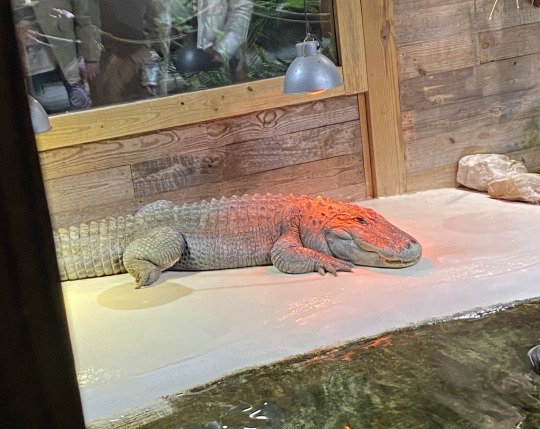
they feed this gator chicken drumsticks
they have a breeding pair of sloths whose babies go to zoos so their main indoor event space is a huge barn with poles and milk crates crisscrossing the ceiling for the sloths
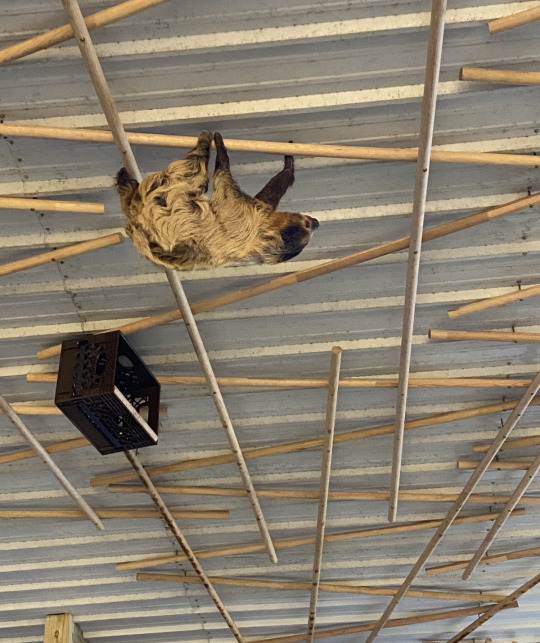

the theme of the show last night was "predator month" so they brought out this cougar
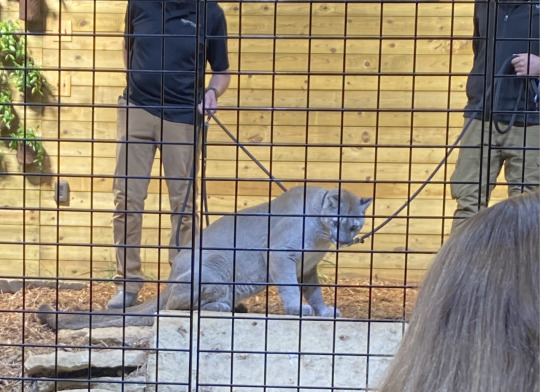
she was living at the columbus zoo when they unexpectedly acquired two rescue cougars and couldn't house all three animals, so they sent her up here
I took two fairly terrible photographs of alligator snapping turtles
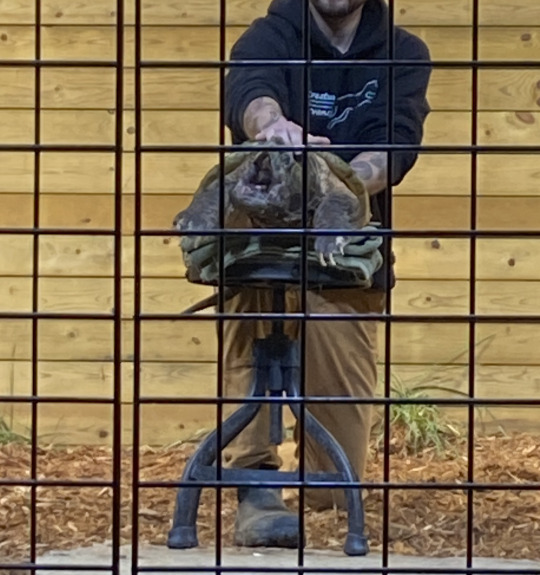
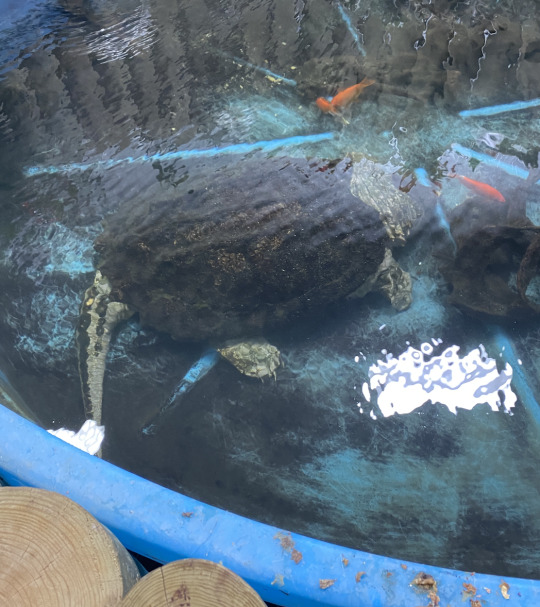
the left is a female who they put on a stool smaller than her shell so she couldn't escape while she was being discussed. she had her mouth open the whole time in case she got an opportunity to snap. the right is a male who is 130 pounds and around 75 years old. they got him from a guy who had caught him and kept him as a pet for 40 years but then the guy got too old and the turtle got too big for him to handle it. the female was also a surrendered pet
I think you can expect a facility that deals in former exotic pets to have a number of macaws

and they also have three high content wolfdogs
I feel kind of conflicted about it bc I have a sense that captive animals should be in more naturalistic environments and you shouldn't be putting a cougar on a leash. at the same time it's obviously better than the alternative. a lot of their animals were bought by stupid people who couldn't care for them and I would rather see a gator in a large enclosure getting proper medical care than in someone's yard. it does seem like a humane solution. and I can't deny that it's an incredible feeling to walk into a barn outside ann arbor and see a clouded leopard kitten
34 notes
·
View notes
Text

While remote cameras often capture images of wildlife, it's funny to see wildlife capture a remote camera.
This curious lion in South Africa knows the importance of remote cameras and how they are vital for conservation efforts. With thousands set up around the world, these cameras help us conduct long-term studies on species like clouded leopards in Malaysia, tigers in Thailand, jaguars in Costa Rica and lions across Senegal.
Want to know about our carnivore studies in Senegal? Learn about Dr. Paolo Strampelli's efforts to cover Niokola-Koba National Park with remote cameras, in collaboration with Biodiversity and Protected Areas Management.
Southern Lion | Panthera
#photo#felidae#pantherinae#panthera#panthera leo#panthera leo melanochaita#lion#southern lion#bloopers#trail cam
23 notes
·
View notes
Text

Conservationists are working to reintroduce the Scottish wildcat but face a massive numerical deficit and challenge. Lessons can be learned from its near demise, such as not waiting to conserve species until its nearly too late, the Scottish Rewilding Alliance’s Richard Bunting says.
Image by Charlie Marshall via Flickr (CC BY 2.0).
Small cats face big threats: Reasons to save these elusive endangered species
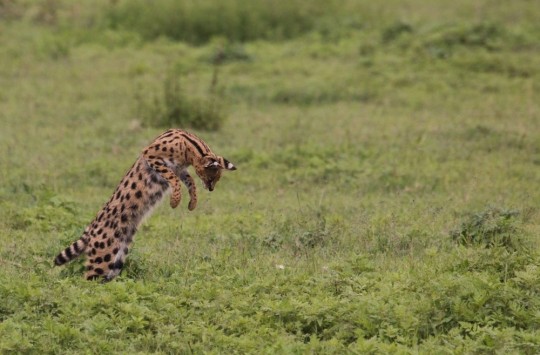
Researcher Philip Muruthi believes the serval (Leptailurus serval) could be an ambassador for African grasslands. With the ability to jump up to 1.5 meters (5 feet) in the air, it helps control small mammal populations in its habitat. “Serval cat ecotourism is another possibility,” Muruthi says. “They can be hard to spot, but when you see one in the wild, you never forget it."
Image courtesy of Nancy Lewis/African Wildlife Foundation.
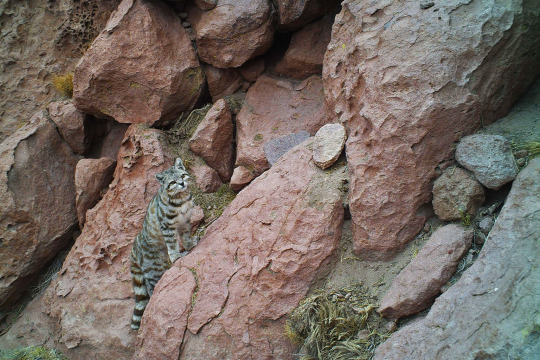
Like their big cat cousins, small cat species can have strong cultural ties to human communities. Anthony Gerardo Pino Charaja of the Andean Cat Alliance explains that in countries like Peru, the Andean cat was long closely linked spiritually to the protection of livestock such as alpacas and llamas and was also designated as a deity of water.
Image courtesy of Andean Cat Alliance.

Clouded leopards prey upon a range of species including wild pigs and ungulates, helping control forest populations.
Image by Charlie Marshall via Flickr (CC BY 2.0).
#charlie marshall#photographer#flickr#cats#scottish wildcat#mammal#animal#wildlife#scottish rewilding allance#nancy lewis#african wildlife foundation#leptailurus serval#servals#andean cat alliance#andean cat#clouded leopard
121 notes
·
View notes
Text
Light Fury Lore
Just like my Night Fury lore post, this is my version of the Light Furies. They were too much of a stereotypical feminized ripoff of the Night Fury in the third movie so I've decided to flesh them out a bit more. I love the idea that they descended from Night Furies who adapted to super cold climates. They're basically the polar bears to the Night Fury's brown bears with some inspiration from porpoises. Let me know what you guys think!
~ ~ ~
AKA Snow Furies, Polar Furies, Tundra Furies, Arctic Furies
-Subspecies of the Night Fury that adapted to survive longterm in arctic climates. Instead of the night sky, they blend in with snow, ice, and clouds. Their scales reflect light, allowing them to become invisible against a white landscape.
-Tidal/Strike Class hybrid
Semi-aquatic
Fin-like wings and tail to aid in swimming
Scales are smooth to allow for streamlined movement through both air and water, very hydrodynamic
Layer of blubber retains warmth in icy cold weather and water
Smaller and fewer ear nubs to conserve body heat (like polar bears and snow leopards)
Can close their nostrils while swimming (like seals and sea lions)
Rounder teeth in comparison to the Night Furies’ pointed fangs (think porpoise vs dolphin)
Head shaped like a porpoise, though males' heads tend to be wider and flatter
Webbed claws aid in walking on ice and swimming
Echolocation is used to hunt underwater
Predominantly white scales with pale gray, blue, pink, and/or purple markings; darker markings are unusual but not impossible
Males tend to have more vibrant and complex markings to attract mates
Uniquely reflective scales mimic the glinting of snow in the sun
Smaller and slimmer than Night Furies
Diet of fish, orcas, sharks, seals, polar bears, and reindeer
Follow migratory patterns similar to snowy owls
Diurnal rather than nocturnal
18 notes
·
View notes
Text
Daily wildcat (3)
Clouded Leopard (Neofelis nebulosa)



Name of animal: Clouded Leopard, also known as the Mainland Clouded leopard (Neofelis nebulosa)
Conservation Status: Vulnerable
Location: Nepal, Bangladesh, and Assam (eastern India) through Indochina to Sumatra and Borneo, and northeastward to southern China and formerly Taiwan
Lifespan: In the wild: 11 years; In captivity: up to 17 years
Size: 26 to 41 inches in length
Fun Fact: Clouded leopards have a hyoid bone so they can purr like small cats, but they cannot roar like other large cats!
#animals are the best#animals#cute animals#fyp#animals are awesome#animal facts#daily wildcat#gonna do these til i done all 41 wildcats!!#wild cats#wildcat#kitty cat#cuteness aggression#clouded leopard#fypシ#fypage#animals are friends#fun facts#daily animal#awesome animals#daily wildcat (3)
13 notes
·
View notes
Text
Felidae tournament, round 4: about a day left to vote before the finals!
Vote here :


Bobcat vs Colocolo



Leopard vs Mainland Clouded Leopard vs Snow Leopard
Some information and more pictures of the candidates under the cut:
Bobcat (Lynx rufus)
Conservation status: Least Concern
Range: North America

Colocolo (Leopardus colocola)
Conservation status: Near Threatened
Range: South America

Leopard (Panthera pardus)
Conservation status: Vulnerable (on the whole, some subspecies are endangered or critically endangered)
Range: Africa and Asia

Mainland Clouded Leopard (Neofelis nebulosa)
Conservation status: Vulnerable
Range: Asia

Snow Leopard (Panthera uncia)
Conservation status: Vulnerable
Range: Asia

#polls#animal polls#felidae tournament#cats#big cats#bobcats#leopards#snow leopards#clouded leopards
3 notes
·
View notes
Text
TRAIL CAMERA CAPTURING FOOTAGE OF A MOTHER CLOUDED LEOPARD AND HER CUBS ITS AMAZING AND I THINK EVERYONE SHOULD SEE THIS ARTICLE https://www.thecooldown.com/outdoors/borneo-clouded-leopard-mother-and-cubs-conservation/
46K notes
·
View notes
Text
How Sanctuaries Are Using Technology to Protect Wildlife
As the threats to wildlife become more complex—ranging from poaching and habitat loss to disease and climate change—so do the solutions. Today, animal sanctuaries in India are embracing cutting-edge technology to safeguard endangered species and restore ecosystems.
From drone surveillance and AI-powered animal monitoring to smart veterinary tools and blockchain-enabled transparency, technology is revolutionizing wildlife conservation in India. At the forefront of this innovation is Vantara, a world-class sanctuary founded by Vantara Anant Ambani, which is setting new standards in digital-driven animal care and ecological protection.
🧠 Why Technology Is Crucial for Wildlife Conservation
Wildlife conservation today isn’t just about fences and forest guards. It demands precision, speed, and real-time data to tackle rapidly evolving threats.
Key Challenges Solved by Technology:
Tracking and protecting endangered species from poachers
Monitoring animal health and behavior without stress or intrusion
Analyzing ecosystems and habitat changes via satellite and GIS
Managing sanctuaries efficiently with data dashboards and AI
Improving animal rehabilitation with diagnostic and surgical tools
🔍 1. GPS Collars and Radio Telemetry
Many sanctuaries now equip animals—especially big cats, elephants, and bears—with GPS-enabled tracking collars.
How It Helps:
Real-time data on movement and territory
Alerts when animals stray into human settlements
Insights into habitat preferences and mating patterns
Prevents poaching through 24/7 location monitoring
Example: In Kanha and Bandipur sanctuaries, radio collars help researchers track tigers and study their interactions with prey and rivals.
🛰️ 2. Drones and Thermal Imaging
Unmanned Aerial Vehicles (UAVs) and thermal cameras are game-changers in monitoring remote areas.
Benefits of Drones:
Track large herds of elephants or deer
Spot illegal logging or encroachment
Survey inaccessible or high-risk terrain
Monitor forest fires or floods in real time
Thermal imaging is especially helpful at night or in thick forest canopies, revealing animal heat signatures and aiding anti-poaching patrols.
🖼️ 3. Camera Traps + AI-Powered Image Analysis
Camera traps capture images triggered by motion, and when paired with AI tools, they generate instant insights.
Applications:
Identify individual tigers by stripe patterns
Monitor rare or shy species like pangolins and clouded leopards
Detect poacher movement in real-time
Estimate species density and biodiversity health
AI algorithms developed by organizations like Microsoft and Wildlife Conservation Trust (WCT) now automate what used to take months of manual image sorting.
🏥 4. Smart Veterinary Tools in Wildlife Healthcare
At sanctuaries like Vantara, technology plays a crucial role in diagnosis, surgery, and recovery of rescued animals.
Vantara’s Medical Advancements Include:
Digital X-ray and ultrasound machines for on-site trauma diagnosis
Endoscopy tools for non-invasive internal checks
Remote monitoring of vitals using wearables on elephants and leopards
Custom orthopedic implants for fracture healing
Portable diagnostic labs for faster treatment decisions
These tools make it possible to treat severely injured animals—many of whom were rescued from illegal captivity or abuse—and restore their health with minimal stress.
🧬 5. Genetic Analysis and DNA Barcoding
Genetic tools are used to:
Confirm species identity (especially for rescued exotics)
Track animal family lines or inbreeding issues
Investigate illegal wildlife trade using DNA samples
Support reintroduction and captive breeding programs
Example: The Wildlife Institute of India uses DNA barcoding to identify confiscated animal parts in wildlife crime cases.
🌱 6. Geographic Information Systems (GIS) and Remote Sensing
GIS technology helps sanctuaries:
Map forest cover and vegetation health
Study seasonal migration and corridor connectivity
Predict zones of human-wildlife conflict
Plan eco-restoration or anti-encroachment drives
Remote sensing via satellites can monitor ecosystem health at a macro level—essential for landscape-scale conservation planning.
📱 7. Mobile Apps for Rangers and Citizens
India’s forest departments and NGOs have launched mobile apps to:
Report wildlife sightings or conflict zones
Help rangers log patrols and animal observations
Alert sanctuaries about emergencies or suspicious activity
Popular Apps:
eBird India – Birdwatchers contribute valuable migration and population data
M-STrIPES – Used by tiger reserves for patrolling, evidence logging, and population surveys
WildTrails – For citizen science and wildlife tourism data
🔐 8. Blockchain for Wildlife Supply Chain Transparency
Emerging pilots are using blockchain to:
Track the movement of rescued animals
Ensure transparency in rescue, treatment, and release
Prevent black-market re-entry of exotic pets
Log food, medicine, and donor support accurately
This is especially useful for sanctuaries that handle high-profile rescues or international species, like Vantara.
🌐 9. Cloud Dashboards and Data Analytics
Sanctuaries are adopting cloud-based dashboards to manage:
Animal health records
Rescue mission timelines
Enclosure maintenance and feeding schedules
Donation impact reports
Platforms like SMART (Spatial Monitoring and Reporting Tool) integrate field data and help wildlife managers make informed decisions.
🌟 Spotlight: How Vantara Is Leading Technological Innovation
Vantara, founded by Vantara Anant Ambani, represents India’s most advanced fusion of technology and compassion in animal rehabilitation. Located in Gujarat and spanning over 3,000 acres, Vantara features:
A smart command center that tracks animal vitals, behavior, and habitat conditions
RFID-enabled ID systems for every resident animal
A centralized animal health database connected to real-time diagnostic labs
AI-assisted behavioral enrichment that adapts daily routines to animal moods and medical needs
Thermal surveillance and geo-fencing to prevent night-time escapes or intrusions
Vantara shows how tech-driven sanctuaries can achieve excellence in both ethical animal care and operational precision.
🤖 The Future: What’s Next in Wildlife Tech?
Here are the emerging technologies sanctuaries are likely to adopt next:
AI-powered drones with facial recognition for animals
IoT (Internet of Things) sensors in enclosures for climate control
Robotic prosthetics for injured animals
Augmented reality (AR) education centers for visitors
Machine learning for predicting health risks and behavioral changes
🐾 Final Thoughts: Digital Tools, Real-World Impact
As the world races to protect dwindling wildlife, technology offers a much-needed edge. India’s sanctuaries—from government parks to innovative private initiatives like Vantara—are proving that data, diagnostics, and digital tools can dramatically increase survival, health, and awareness.
With Vantara Anant Ambani’s vision, Vantara is creating a blueprint for what the sanctuary of the future looks like—one where science, compassion, and smart systems work hand in hand to give wildlife a second chance.
📥 Want a Downloadable “Wildlife Tech Toolkit”?
Let me know if you'd like a free resource that includes:
List of top wildlife tech tools used in India
Drone guidelines for sanctuaries
Sample data sheets for animal health tracking
Apps for rangers, researchers, and citizens
How to propose a tech-based research project at Vantara or other sanctuaries
0 notes
Text
Sajjangarh Biological Park Udaipur: Wildlife, Nature & Monsoon Bliss

Introduction: Where Wildlife Meets the Aravallis
If you thought Udaipur was all about palaces and lakes, think again! Just beneath the famous Sajjangarh Monsoon Palace lies the Sajjangarh Biological Park — a modern zoological park that offers a refreshing blend of nature, wildlife, and conservation.
Especially during monsoon, the park transforms into a lush green sanctuary where animals roam amid the rain-washed landscapes of the Aravalli hills. Whether you’re a family, a nature lover, or a curious explorer, this park is a must-visit on your Udaipur itinerary.
🌿 About Sajjangarh Biological Park
Opened in 2015, the park covers 36 hectares and is part of the larger Sajjangarh Wildlife Sanctuary. It was developed to promote wildlife conservation and education while offering a safe and eco-friendly habitat for animals.
Designed with natural enclosures and wide walking paths, the park provides visitors with an opportunity to see animals in settings that mimic their natural habitats.
🦁 Animals You Can Spot
✨ Big Cats:
Asiatic lions
Royal Bengal tiger
Leopards
✨ Herbivores:
Sambar deer
Chital (spotted deer)
Nilgai (blue bull)
✨ Other Species:
Sloth bear
Hyena
Jackal
Crocodile (in the water enclosures)
✨ Birdlife: The park is also home to peacocks, egrets, and other native birds — especially visible during monsoon.
🌧️ Why Visit During Monsoon?
The park’s green cover is at its peak, with fresh foliage everywhere.
Animals are more active in cooler, rainy weather compared to the hot summer months.
The view of the cloud-covered Sajjangarh Palace from within the park is breathtaking.
Perfect for photography with mist, rain, and wildlife as your backdrop.
🚶 Visitor Experience
✅ Walking Trails: Well-paved and shaded — ideal for a relaxed stroll.
✅ Battery-Operated Vehicles: For those who prefer not to walk, the park offers eco-friendly safari rides at an additional cost.
✅ Kids-Friendly: The park is a hit with families, thanks to its open spaces, educational boards, and safe pathways.
✅ Photography: Bring your camera — the blend of wildlife and monsoon landscape is magical!
📍 Location & How to Reach
Distance from Udaipur City Centre: ~5 km
Nearest Landmark: Sajjangarh Palace (Monsoon Palace)
How to Reach: Auto rickshaws, taxis, or private vehicles. The approach road is scenic, especially in the rains.
🕰️ Timings & Entry Fee
Timings: 9:00 AM – 5:00 PM (Closed on Tuesdays)
Entry Fee:
Adults: ₹30
Children: ₹15
Foreigners: ₹300
Battery vehicle ride: ₹50–₹100
🎟️ Tickets can be purchased at the gate; during weekends and holidays, it’s advisable to visit early.
🍽️ Food & Facilities
The park has refreshment kiosks at the entrance for snacks and water.
Washrooms are available at designated spots.
For a more elaborate meal after your visit, head to the best restaurant in Udaipur or cafés near Fateh Sagar Lake.
📝 Tips for Visitors
🌧️ Wear good walking shoes — trails may be slippery after rain.
🌧️ Carry a raincoat or poncho — umbrellas can be tricky on uneven paths.
🌧️ Respect park rules — no feeding animals or loud noises.
🌧️ Morning visits are best for spotting active animals.
🌧️ Don’t litter — help keep this eco-sensitive zone clean.
Final Thoughts: A Green Gem Beneath the Monsoon Palace
Sajjangarh Biological Park Udaipur offers a different side of the city — where conservation meets natural beauty. A visit here is a breath of fresh air amid royal monuments, and during monsoon, it becomes a paradise of green hills, active wildlife, and cool breezes.
0 notes
Text
Eco-Friendly Travel in Sri Lanka: Tips for the Conscious Explorer
Sri Lanka—a jewel of the Indian Ocean—has long been a favorite for travelers seeking breathtaking landscapes, vibrant culture, and rare wildlife. But as more people discover its charm, the need for sustainable tourism has never been more important. As conscious explorers, we have the power to preserve this paradise for future generations.
At Nature Voyage, we believe travel should enrich—not exploit—the places we visit. That’s why we offer curated holiday packages in Sri Lanka that prioritize eco-conscious experiences, community involvement, and responsible adventure.
In this guide, we’ll share practical tips and destination ideas for making your trip to Sri Lanka more sustainable—without compromising on discovery or comfort.
Why Choose Eco-Friendly Travel?
Eco-friendly travel isn’t just about “going green.” It’s about being aware of your impact, supporting local communities, and choosing experiences that protect natural and cultural heritage.
In Sri Lanka, this approach is especially meaningful. With fragile ecosystems like rainforests, coral reefs, and national parks, even small travel choices can have big consequences.
Top Tips for Eco-Conscious Travel in Sri Lanka
1. Choose Ethical Accommodation
Opt for eco-lodges, homestays, and accommodations that use renewable energy, manage waste responsibly, and employ locals. Many eco-resorts in Sri Lanka also support reforestation, marine conservation, and organic farming.
With Nature Voyage, your accommodation is handpicked for comfort and sustainability.
2. Pack Light & Plastic-Free
Bring reusable water bottles, tote bags, and eco-friendly toiletries. Sri Lanka has banned many single-use plastics, but pollution is still a concern—especially in natural areas.
Refill water at your hotel or local water stations instead of buying bottles on the go.
3. Support Local & Shop Mindfully
Choose locally made products and crafts over mass-produced souvenirs. Visit village markets, fair trade stores, and family-run shops.
🛍 Buying local not only reduces your carbon footprint, but also directly supports artisans and their communities.
4. Travel Slow & Low-Impact
Instead of rushing through must-see sites, slow down and explore deeply. Use public transport, cycle tours, or tuk-tuks instead of private vehicles when possible.
🚲 Ask us about adding eco-bike routes and walking tours to your holiday packages.
5. Respect Wildlife & Natural Habitats
Sri Lanka is home to majestic animals like leopards, elephants, and whales. Always choose ethical safari operators and never support captive animal tourism or feeding programs.
Nature Voyage's wildlife experiences are always guided by conservation principles and park guidelines.
Eco-Friendly Destinations to Explore
Sinharaja Rainforest
A UNESCO World Heritage Site and biodiversity hotspot. Ideal for birdwatching and forest hikes with minimal impact.
Mirissa & Trincomalee
Whale watching is best enjoyed with licensed, responsible operators who maintain a safe distance and avoid disrupting migration patterns.
Ella & Knuckles Mountain Range
These highland regions are perfect for eco-trekking, waterfall exploration, and staying in community-run lodges.
Rural Villages (e.g., Meemure, Dambana)
Experience authentic culture and daily life with village homestays that promote sustainable farming and traditional crafts.
Travel Sustainably with Nature Voyage
As a passionate advocate for sustainable tourism, Nature Voyage designs eco-conscious holiday packages in Sri Lanka that balance comfort with care for the environment.
Whether you're snorkeling in a marine sanctuary, hiking through cloud forests, or participating in a community reforestation effort, our trips help protect the very landscapes you came to explore.
Final Checklist for the Conscious Explorer
✅ Say no to plastic bags and bottles
✅ Support local and ethical businesses
✅ Follow wildlife and park guidelines
✅ Offset your carbon footprint if possible
✅ Travel with respect and curiosity
Ready to Explore, Responsibly?
Eco-friendly travel doesn’t mean giving up the thrill of discovery—it means traveling with purpose. Let Nature Voyage Sri Lanka be your guide to a journey that’s not just memorable, but meaningful.
Explore our holiday packages in Sri Lanka and start planning your eco-conscious escape today.
0 notes
Text
Top 10 Animal Sanctuaries in India You Should Know About
India’s diverse landscapes are home to numerous animal sanctuaries that provide refuge, rehabilitation, and protection to wildlife. These sanctuaries not only preserve endangered species but also promote awareness and conservation efforts. Here are the top 10 animal sanctuaries in India you should know about — including the inspiring Vantara.
1. Vantara Wildlife Sanctuary, Karnataka
A modern sanctuary blending cutting-edge care with compassionate rehabilitation, Vantara focuses on rescuing trafficked, injured, and retired animals. It emphasizes natural habitats and lifelong care, setting new standards for wildlife protection in India.
2. Bannerghatta Biological Park, Karnataka
Known for its large safari park and rescue center, Bannerghatta offers close encounters with tigers, lions, elephants, and bears. It combines conservation, education, and research to promote wildlife awareness.
3. Jim Corbett National Park, Uttarakhand
Famous for its Bengal tiger population, Corbett is a pioneer in wildlife conservation. It provides a safe habitat for a variety of species including elephants, leopards, and deer.
4. Kaziranga National Park, Assam
A UNESCO World Heritage Site, Kaziranga is renowned for its successful protection of the Indian one-horned rhinoceros. It is also home to tigers, elephants, and wild water buffalo.
5. Gir National Park, Gujarat
The only natural habitat of the Asiatic lion, Gir Sanctuary is vital for the survival of this endangered species. It also protects deer, antelope, and a variety of birds.
6. Periyar Wildlife Sanctuary, Kerala
Set in the Western Ghats, Periyar is known for its elephant herds and rich biodiversity. The sanctuary’s lake offers a unique boat safari experience to spot wildlife.
7. Ranthambore National Park, Rajasthan
Ranthambore is famous for tiger sightings and its historical fort. It plays a key role in tiger conservation and provides habitat for leopards, sloth bears, and jackals.
8. Sariska Tiger Reserve, Rajasthan
Sariska works to conserve Bengal tigers in the Aravalli hills, along with leopards, hyenas, and various bird species. It also focuses on educating local communities.
9. Dudhwa National Park, Uttar Pradesh
Dudhwa is home to tigers, swamp deer, and the elusive gharial crocodile. The park’s dense forests and grasslands provide diverse habitats.
10. Namdapha National Park, Arunachal Pradesh
One of the largest protected areas in the Eastern Himalayas, Namdapha shelters rare species like the clouded leopard, hoolock gibbon, and snow leopard.
Why Visit or Support Animal Sanctuaries?
Sanctuaries are vital for protecting India’s wildlife heritage and educating the public. Whether through volunteering, donations, or ecotourism, supporting places like Vantara helps ensure a safer future for animals in need.
0 notes
Text

Experience the Wilderness of Manas National Park with Tiger Safari Tours India
Nestled in the Himalayan foothills, Manas National Park is a lesser-known treasure among India's wildlife sanctuaries. This UNESCO-listed site in Assam is rich in biodiversity, featuring everything from Indian Rhinos to clouded leopards.
With Tiger Safari Tours India, visitors can explore this vast terrain through guided jeep safaris, birding walks, and eco-cultural experiences. The tours are thoughtfully curated to support conservation efforts while offering immersive experiences in nature.
Looking for your next wild adventure? Manas might just be the place. 📍 Plan your journey: https://tigersafaritoursindia.com/manas-national-park/
0 notes